名词
图片预览


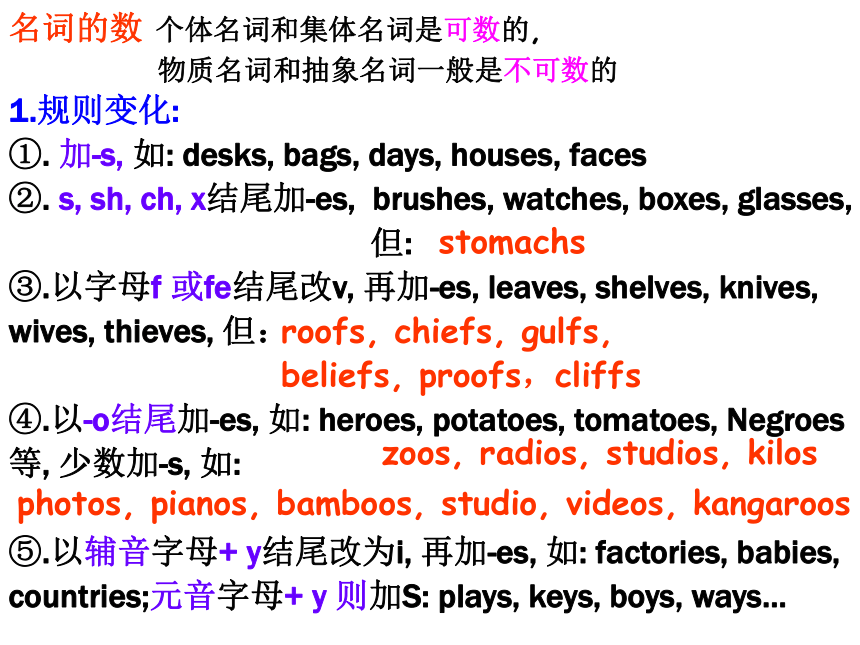
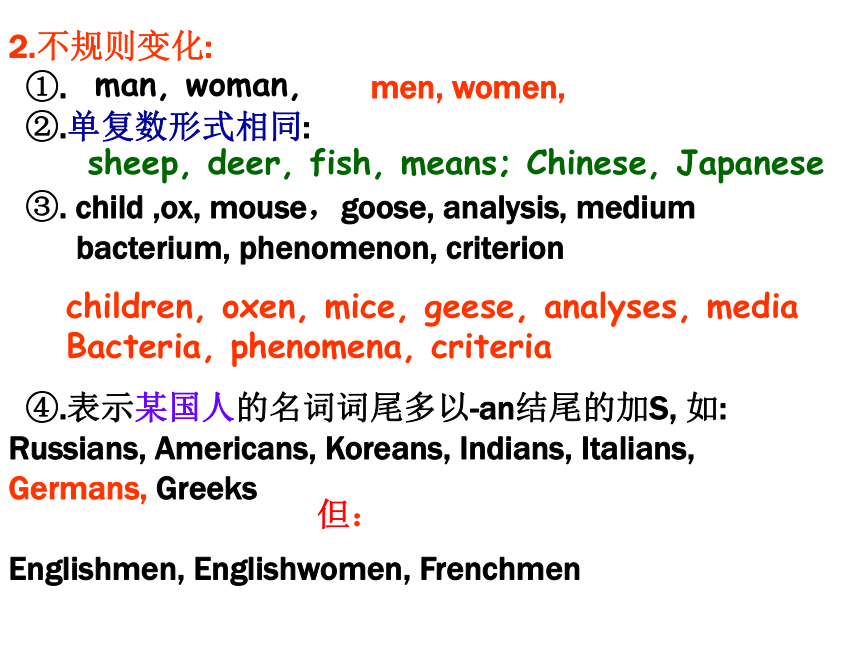
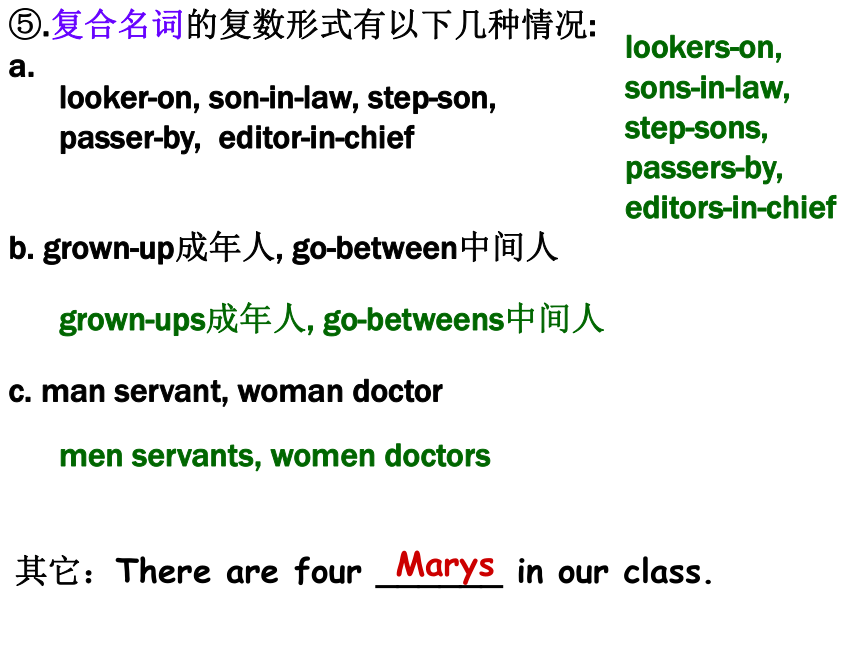
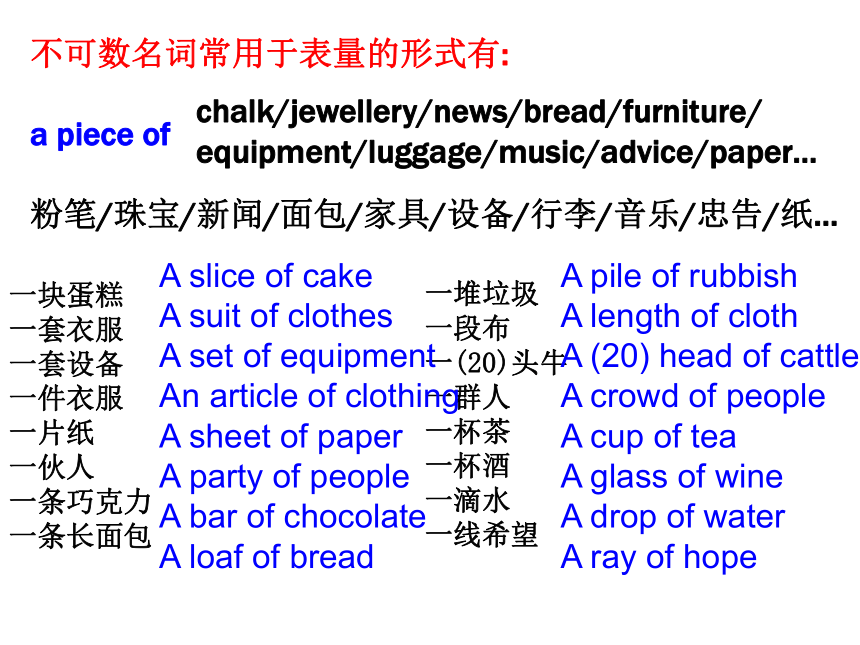
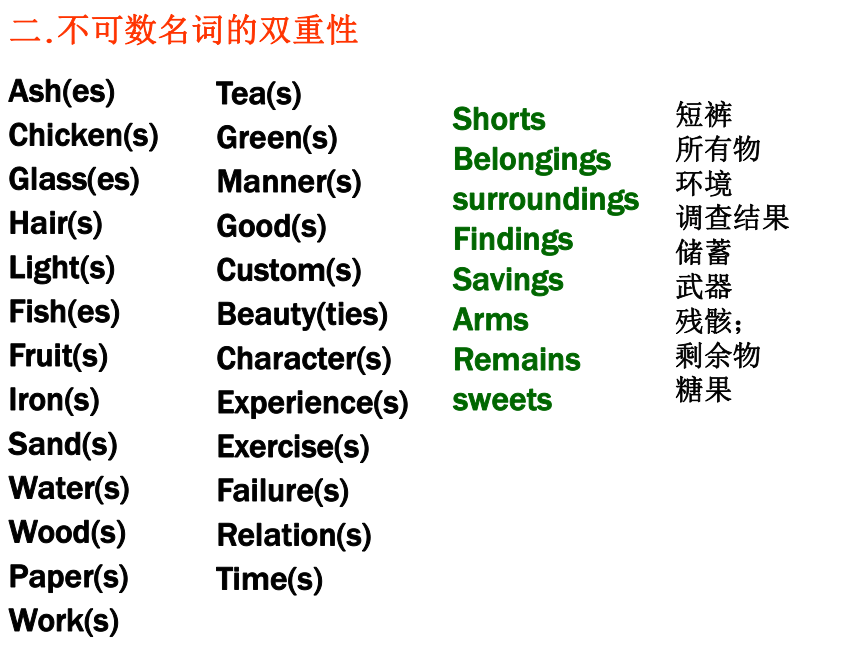
文档简介
课件17张PPT。名 词高三英语复习(1)名词的种类
1.专有名词: 表示具体的人, 事物, 地点或机构的专有
名称, 如: China, Lei Feng
2.普通名词: 表示某类人或某类事物的名称, 又可分为
四类
①.个体名词: 表示单个的人或事物, 如: doctor,
house, tree, orange, photo
②.集体名词: 表示一群人或事物的总称, 如: class,
family, group
③.物质名词: 表示无法分出个体的物质, 如: rice,
steel, water, coal, cotton
④.抽象名词: 表示抽象概念的词, 如: victory,
health, progress, friendship名词的数 个体名词和集体名词是可数的,
物质名词和抽象名词一般是不可数的
1.规则变化:
①. 加-s, 如: desks, bags, days, houses, faces
②. s, sh, ch, x结尾加-es, brushes, watches, boxes, glasses,
但:
③.以字母f 或fe结尾改v, 再加-es, leaves, shelves, knives, wives, thieves, 但:
④.以-o结尾加-es, 如: heroes, potatoes, tomatoes, Negroes等, 少数加-s, 如:
⑤.以辅音字母+ y结尾改为i, 再加-es, 如: factories, babies, countries;元音字母+ y 则加S: plays, keys, boys, ways…stomachsroofs, chiefs, gulfs,
beliefs, proofs,cliffszoos, radios, studios, kilosphotos, pianos, bamboos, studio, videos, kangaroos2.不规则变化:
①. men, women,
②.单复数形式相同:
③. child ,ox, mouse,goose, analysis, medium
bacterium, phenomenon, criterion
④.表示某国人的名词词尾多以-an结尾的加S, 如: Russians, Americans, Koreans, Indians, Italians, Germans, Greeks
Englishmen, Englishwomen, Frenchmenman, woman, sheep, deer, fish, means; Chinese, Japanesechildren, oxen, mice, geese, analyses, media
Bacteria, phenomena, criteria 但:⑤.复合名词的复数形式有以下几种情况:
a. looker-on, son-in-law, step-son,
passer-by, editor-in-chiefb. grown-up成年人, go-between中间人c. man servant, woman doctor 其它:There are four ______ in our class.Maryslookers-on,
sons-in-law,
step-sons,
passers-by,
editors-in-chiefmen servants, women doctorsgrown-ups成年人, go-betweens中间人不可数名词常用于表量的形式有:
a piece of
粉笔/珠宝/新闻/面包/家具/设备/行李/音乐/忠告/纸… chalk/jewellery/news/bread/furniture/
equipment/luggage/music/advice/paper…一块蛋糕
一套衣服
一套设备
一件衣服
一片纸
一伙人
一条巧克力
一条长面包一堆垃圾
一段布
一(20)头牛
一群人
一杯茶
一杯酒
一滴水
一线希望A slice of cake
A suit of clothes
A set of equipment
An article of clothing
A sheet of paper
A party of people
A bar of chocolate
A loaf of breadA pile of rubbish
A length of cloth
A (20) head of cattle
A crowd of people
A cup of tea
A glass of wine
A drop of water
A ray of hope二.不可数名词的双重性 Ash(es)
Chicken(s)
Glass(es)
Hair(s)
Light(s)
Fish(es)
Fruit(s)
Iron(s)
Sand(s)
Water(s)
Wood(s)
Paper(s)
Work(s)Tea(s)
Green(s)
Manner(s)
Good(s)
Custom(s)
Beauty(ties)
Character(s)
Experience(s)
Exercise(s)
Failure(s)
Relation(s)
Time(s)Shorts
Belongings
surroundings
Findings
Savings
Arms
Remains
sweets短裤
所有物
环境
调查结果
储蓄
武器
残骸;
剩余物
糖果Thanks to
Give regards to
Take pains
With best wishes
Have words with
In high spirits
Make repairs
Shake hands with
Make preparations for
Make friends with
Congratulations to sb. on sth.
Two coffees, please!幸亏
问候。。。
下功夫
祝好
争吵
情绪高昂
修理
握手
准备。。。
与。。。交朋友
祝贺某人某事
两杯咖啡名词的所有格:
1.表示有生命的东西(人或物) my father’s room
①.以-s或-es-结尾的复数名词的所有格只在名词后加’, 如: the teachers’ reading room, the masses’ advice
②.不以-s结尾的复数名词的所有格要加’s, 如: the people’s needs, women’s rights
③.若专有名词以-s结尾, 它的所有格一般只加’, 但也有加’s的, 读作[iz], 如: Burns’s poems或Burns’ poem
④.复合名词或短语的所有格的’s加在最后一个词之后, her son-in-law’s photo
somebody else’s car她养子的照片
他人的车⑤. 两人共有, 则在后面一个名词后加’s;
如果不是两者共有, 则在两个名词之后都要加’s,
Jane and Helen’s room
Bill’s and Tom’s rooms
(Bill的房间和Tom共用的房间)
(Bill的房间和Tom的房间)⑥.在表示店铺, 某人的家的名词所有格后面, 一般省掉它所修饰的名词,
2.表示无生命的名词用of词组, the cover of the book,
但, 表示时间, 距离, 重量, 国家, 城市, 地点等无生命的名词也可用’s形式the tailor’s
the barber’s
at my uncle’s裁缝店,
理发店,
在叔叔家half an hour’s walk
today’s newspaper
a pound’s weight
London’s traffic system半小时的步行路程
今天的报纸
一磅的重量
伦敦的交通系统a friend of my father’s
two brothers of his,
some inventions of Edison’s,
these poems of Li Bai’s, 4. of +名词的’s 双重所有格.
在表示所属物的名词前有不定冠词, 数词,不定代词或指示代词(如a, two, some, any, such, no, a few, this, that, these, those等)时, 常用双重所有格表示所属关系,
我父亲的一位朋友
他的两个兄弟
爱迪生的一些发明
李白的这些诗 区别: a picture of my father
a picture of my father’s 照片中的人是我父亲
照片属于我父亲用to表示所有格:
影院入口
经理秘书
成功之道
问题答案
课文注解
房间钥匙
欧洲之行
The entrance to the cinema
The secretary to the manager
The way to success
The answer to the question
The notes to the text
The key to the room
A journey to Europe
用for表示所有格:
电影票
咳嗽药
儿童书籍
玛丽的生日礼物The ticket for the film
The medicine for one’s cough
Books for children
A gift for Mary
用with表示所有格:
金发女郎
戴眼镜的男人
有礼貌的人
历史悠久的国家A girl with golden hair
A man with glasses
A man with good manners
A country with a long history
名词作定语与形容词作定语的区别:
Gold watch
Golden watch
Golden years
beauty shop
Beautiful shop
Mud track
Muddy track 金表
金色的表
黄金岁月
美容店
美丽的店铺
泥路
泥泞的路
名词的性:
1.用不同的词
2.阳性+ ess, ine等表阴性
3. 用boy, girl, man, woman, he, she, 等加在名词前表
不同的性别Nephew bull (ox) bridegroom
Sir monk wizard Actor prince waiter
host emperor hero He-goat she- goat niece cow bride
madam nun witch actress princess waitress
hostess empress heroine名词的主动和被动意义:
Trainer Trainee
Employer Employee
Examiner Examinee
Tester testee
Interviewer Interviewee
Investigator Investigatee 培训者 受训者
雇主 雇员
测试者 受试者
采访者 被采访者
调查者 被调查者
1.专有名词: 表示具体的人, 事物, 地点或机构的专有
名称, 如: China, Lei Feng
2.普通名词: 表示某类人或某类事物的名称, 又可分为
四类
①.个体名词: 表示单个的人或事物, 如: doctor,
house, tree, orange, photo
②.集体名词: 表示一群人或事物的总称, 如: class,
family, group
③.物质名词: 表示无法分出个体的物质, 如: rice,
steel, water, coal, cotton
④.抽象名词: 表示抽象概念的词, 如: victory,
health, progress, friendship名词的数 个体名词和集体名词是可数的,
物质名词和抽象名词一般是不可数的
1.规则变化:
①. 加-s, 如: desks, bags, days, houses, faces
②. s, sh, ch, x结尾加-es, brushes, watches, boxes, glasses,
但:
③.以字母f 或fe结尾改v, 再加-es, leaves, shelves, knives, wives, thieves, 但:
④.以-o结尾加-es, 如: heroes, potatoes, tomatoes, Negroes等, 少数加-s, 如:
⑤.以辅音字母+ y结尾改为i, 再加-es, 如: factories, babies, countries;元音字母+ y 则加S: plays, keys, boys, ways…stomachsroofs, chiefs, gulfs,
beliefs, proofs,cliffszoos, radios, studios, kilosphotos, pianos, bamboos, studio, videos, kangaroos2.不规则变化:
①. men, women,
②.单复数形式相同:
③. child ,ox, mouse,goose, analysis, medium
bacterium, phenomenon, criterion
④.表示某国人的名词词尾多以-an结尾的加S, 如: Russians, Americans, Koreans, Indians, Italians, Germans, Greeks
Englishmen, Englishwomen, Frenchmenman, woman, sheep, deer, fish, means; Chinese, Japanesechildren, oxen, mice, geese, analyses, media
Bacteria, phenomena, criteria 但:⑤.复合名词的复数形式有以下几种情况:
a. looker-on, son-in-law, step-son,
passer-by, editor-in-chiefb. grown-up成年人, go-between中间人c. man servant, woman doctor 其它:There are four ______ in our class.Maryslookers-on,
sons-in-law,
step-sons,
passers-by,
editors-in-chiefmen servants, women doctorsgrown-ups成年人, go-betweens中间人不可数名词常用于表量的形式有:
a piece of
粉笔/珠宝/新闻/面包/家具/设备/行李/音乐/忠告/纸… chalk/jewellery/news/bread/furniture/
equipment/luggage/music/advice/paper…一块蛋糕
一套衣服
一套设备
一件衣服
一片纸
一伙人
一条巧克力
一条长面包一堆垃圾
一段布
一(20)头牛
一群人
一杯茶
一杯酒
一滴水
一线希望A slice of cake
A suit of clothes
A set of equipment
An article of clothing
A sheet of paper
A party of people
A bar of chocolate
A loaf of breadA pile of rubbish
A length of cloth
A (20) head of cattle
A crowd of people
A cup of tea
A glass of wine
A drop of water
A ray of hope二.不可数名词的双重性 Ash(es)
Chicken(s)
Glass(es)
Hair(s)
Light(s)
Fish(es)
Fruit(s)
Iron(s)
Sand(s)
Water(s)
Wood(s)
Paper(s)
Work(s)Tea(s)
Green(s)
Manner(s)
Good(s)
Custom(s)
Beauty(ties)
Character(s)
Experience(s)
Exercise(s)
Failure(s)
Relation(s)
Time(s)Shorts
Belongings
surroundings
Findings
Savings
Arms
Remains
sweets短裤
所有物
环境
调查结果
储蓄
武器
残骸;
剩余物
糖果Thanks to
Give regards to
Take pains
With best wishes
Have words with
In high spirits
Make repairs
Shake hands with
Make preparations for
Make friends with
Congratulations to sb. on sth.
Two coffees, please!幸亏
问候。。。
下功夫
祝好
争吵
情绪高昂
修理
握手
准备。。。
与。。。交朋友
祝贺某人某事
两杯咖啡名词的所有格:
1.表示有生命的东西(人或物) my father’s room
①.以-s或-es-结尾的复数名词的所有格只在名词后加’, 如: the teachers’ reading room, the masses’ advice
②.不以-s结尾的复数名词的所有格要加’s, 如: the people’s needs, women’s rights
③.若专有名词以-s结尾, 它的所有格一般只加’, 但也有加’s的, 读作[iz], 如: Burns’s poems或Burns’ poem
④.复合名词或短语的所有格的’s加在最后一个词之后, her son-in-law’s photo
somebody else’s car她养子的照片
他人的车⑤. 两人共有, 则在后面一个名词后加’s;
如果不是两者共有, 则在两个名词之后都要加’s,
Jane and Helen’s room
Bill’s and Tom’s rooms
(Bill的房间和Tom共用的房间)
(Bill的房间和Tom的房间)⑥.在表示店铺, 某人的家的名词所有格后面, 一般省掉它所修饰的名词,
2.表示无生命的名词用of词组, the cover of the book,
但, 表示时间, 距离, 重量, 国家, 城市, 地点等无生命的名词也可用’s形式the tailor’s
the barber’s
at my uncle’s裁缝店,
理发店,
在叔叔家half an hour’s walk
today’s newspaper
a pound’s weight
London’s traffic system半小时的步行路程
今天的报纸
一磅的重量
伦敦的交通系统a friend of my father’s
two brothers of his,
some inventions of Edison’s,
these poems of Li Bai’s, 4. of +名词的’s 双重所有格.
在表示所属物的名词前有不定冠词, 数词,不定代词或指示代词(如a, two, some, any, such, no, a few, this, that, these, those等)时, 常用双重所有格表示所属关系,
我父亲的一位朋友
他的两个兄弟
爱迪生的一些发明
李白的这些诗 区别: a picture of my father
a picture of my father’s 照片中的人是我父亲
照片属于我父亲用to表示所有格:
影院入口
经理秘书
成功之道
问题答案
课文注解
房间钥匙
欧洲之行
The entrance to the cinema
The secretary to the manager
The way to success
The answer to the question
The notes to the text
The key to the room
A journey to Europe
用for表示所有格:
电影票
咳嗽药
儿童书籍
玛丽的生日礼物The ticket for the film
The medicine for one’s cough
Books for children
A gift for Mary
用with表示所有格:
金发女郎
戴眼镜的男人
有礼貌的人
历史悠久的国家A girl with golden hair
A man with glasses
A man with good manners
A country with a long history
名词作定语与形容词作定语的区别:
Gold watch
Golden watch
Golden years
beauty shop
Beautiful shop
Mud track
Muddy track 金表
金色的表
黄金岁月
美容店
美丽的店铺
泥路
泥泞的路
名词的性:
1.用不同的词
2.阳性+ ess, ine等表阴性
3. 用boy, girl, man, woman, he, she, 等加在名词前表
不同的性别Nephew bull (ox) bridegroom
Sir monk wizard Actor prince waiter
host emperor hero He-goat she- goat niece cow bride
madam nun witch actress princess waitress
hostess empress heroine名词的主动和被动意义:
Trainer Trainee
Employer Employee
Examiner Examinee
Tester testee
Interviewer Interviewee
Investigator Investigatee 培训者 受训者
雇主 雇员
测试者 受试者
采访者 被采访者
调查者 被调查者
